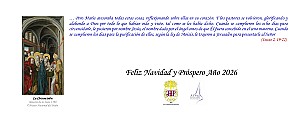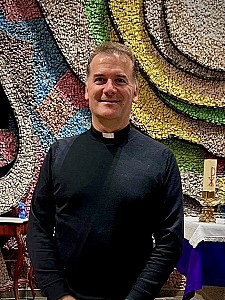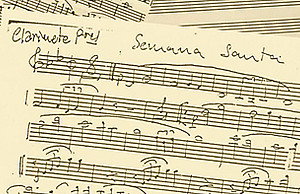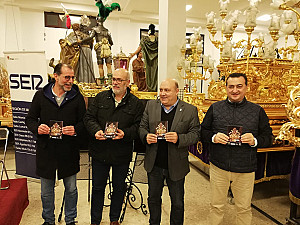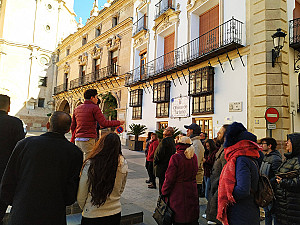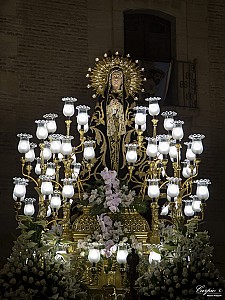La participación de una primitiva Imagen con la advocación de María Santísima de la Soledad en la Procesión del Santo Entierro está constatada desde su llegada a Cieza en los primeros años de mil seiscientos. De hecho su Cofradía también se ocupaba de determinadas funciones de Iglesia, entre ellas la del descendimiento del Viernes Santo: "…en el Biernes Santo por la mañana llevar desde el convento de esta Villa a su Iglesia Parrochial para la funcion de su descendimiento a el Santo Christo que esta en otro convento para que se le a de formar su tablado enlutado…", así lo ponía de manifiesto en 1712 el regidor D. Francisco Marín-Ordóñez al estipular que sus descendientes debían seguir costeándolas.
Esa primera Imagen de 'La Soledad' habría desfilado al menos durante el siglo XVII y hasta la constitución de su propia Cofradía en el seno de la Cofradía de la Sangre de Cristo, como se desprende de una escritura, fechada en 1671, de recepción de enseres de la Imagen por parte del Mayordomo de la Cofradía de la Sangre de manos de la viuda del que había sido su responsable: "En la villa de Cieza en diez y ocho dias del mes de agosto de mil seiscientos y setenta y un años ante mi el escribano publico y testigos parecio presente Francisco perez Carpintero el mayor mayordomo de la cofradía de la sangre de Cristo vecino de esta dicha villa y dijo que por quanto fin y muerte de lorenço motellon a subcedido en la dicha cofradía quien la tubo a su cargo y entreveía antes quienes hoy aquí se reconozca la ropa que tiene y adornos de bestir la dicha cofradía y la virgen de la soledad. --- y recibo de Juana despinosa biuda del dicho Lorenço motellon los vienes y ropas siguientes…".
Es en 1692 cuando, junto con la Cofradía de Jesús de Nazareno, la Cofradía de María Santísima de la Soledad, denominada en sus orígenes y durante bastante tiempo después Cofradía de Nuestra Señora de la Soledad, solicita su erección estableciendo constituciones propias para "poder solemniçar la semana santa de cada una de las procesiones que seaçen con estas santas Ynsinias los dias Jueves y Viernes". Sin embargo, la constitución efectiva no se produce hasta el 11 de marzo 1730, momento en el que el primer Libro de Actas de la Cofradía explicita que sus fundadores obtuvieron la aprobación de los dieciocho preceptos por los que se habían de regir por el Provisor y Vicario General de la Diócesis, Dr. D. Francisco Linero y Lezcano. Resulta cuando menos extraño que entre la solicitud de constitución y la constitución propiamente dicha haya transcurrido un periodo de tiempo tan largo; cabe la posibilidad, muy remota, de que durante esos casi cuarenta años la Cofradía de Nuestra Señora de la Soledad hubiese estado asociada a la de Jesús Nazareno (así puede pensarse siguiendo el testamento de D. Juan Gómez de Aledo y Abellán: "y asimismo me asista y acompañe mi cuerpo la Hermandad de Nuestro Padre Jesús y Nuestra Señora de la Soledad, en atención a haber sido Hermano Mayor de la misma").
Todos los miembros de la Cofradía, tal como estipulaban sus Estatutos, tenían ascendencia social ligada a la nobleza y entre ellos figuraban apellidos tan ilustres en la localidad como los de Buitrago Angostos, Marín Castaño, Marín Ordóñez, Ruiz Soler, Marín Blázquez de Padilla, García Ruiz Melgarejo, Falcón, Marín Talón, de la Peña, Roldán, Yarza, Puche, Bermúdez o Abellán. Sus reglas restringían el número de cofrades a treinta y cuatro, aunque en algunos casos se aceptaba a alguno en calidad de supernumerario, para suplir la baja de algún Cofrade enfermo generalmente. Asimismo el ingreso en la Cofradía se efectuaba mediante la presentación de un memorial que el Secretario leía en Junta, procediéndose después a votar secretamente la admisión del aspirante, repartiéndose para tal caso habas blancas, que daban el voto, y negras, que lo denegaban. El Cofrade debía observar una muy recta conducta tanto moral como religiosa, basada en los preceptos incluidos en sus reglas, y debían asistir a la Procesión vestidos de riguroso luto.
Las Hermanas empezaron a formar parte activa de la Cofradía a mediados del siglo XVIII, aunque prácticamente desde su fundación figuraron en la Vela del Novenario y en la Vela del Santísimo, y en el alumbrado de la Procesión (las tradicionales 'Lloronas', señoras vestidas de riguroso luto). Su número se limitó en un principio a treinta y seis, debiendo ser además esposas o hijas de los propios Cofrades; este número, no obstante, se vio ampliado a principios del XIX por el deseo de muchas señoras de figurar en la Procesión. De todas formas no pudieron evitarse altercados con "mujeres que por su nacimiento y exterioridades hacen deslucir el Acto...", lo que propició una serie de curiosas medidas que los evitaran en lo sucesivo; entre ellas "se resolvió se haga a costa de las mismas ermanas cuatro sitiales de terciopelo carmesí" con que aislar al grupo de Hermanas del resto de mujeres que asistían a los Novenarios. También la epidemia de peste de 1811 influyó de tal manera en la Cofradía que al año siguiente se permitió desfilar incluso a los pretendientes que todavía no habían sido admitidos.
Los cargos directivos se elegían en la Junta General que se celebraba siempre el domingo segundo de Pascua de Resurrección, recayendo la máxima autoridad sobre el Hermano Mayor, cuyo mandato duraba un año, y que era elegido por escrupuloso orden de antigüedad. El cura párroco asistía siempre a los Cabildos de la Cofradía en calidad de Presidente. El resto de responsabilidades se las repartían Secretario, Tesorero o Depositario, Discretos o Vocales (en número de seis primero y de cuatro después) y Colector de Testamentos, encargado de recabar de los albaceas testamentarios los bienes legados a la Cofradía; los miembros elegidos desempeñaban su cargo por espacio de un año, aunque era frecuente que resultaran nuevamente reelegidos o que incluso lo desempeñaran con carácter vitalicio.
Desde un primer momento se dejó sentir la necesidad de que una persona cuidase de la Imagen y de los enseres de la Cofradía, y así en 1730 se nombró primera Camarera de la Cofradía a Dña. Inés Navarro, Sola y Martínez, que lo fue hasta el año de su fallecimiento, 1735, pasando el cargo a su hija Catalina. Sus obligaciones no eran otras que vestir y alhajar a la Imagen según lo requerían las festividades. Desde mediados del XVIII el ajuar de la Imagen se guardó en la sacristía de la Iglesia parroquial de Nuestra Señora de la Asunción.
Por su parte el Cofrade que ingresaba en la Hermandad debía satisfacer una pequeña cantidad (ocho reales de plata) y aportar un blandón de cera de tres libras, compromiso que se renovaba cada año. Con todo no siempre gozaron los Cofrades de una buena situación para hacer frente a estos donativos. La Cofradía no obstante dispuso de otras importantes fuentes de ingresos: las mandas testamentarias a favor de la misma, usuales en aquella época (así en 1730: "asimismo que por el testamento por el que Dña. María Egipcíaca Artes dotó, legó y mandó a María Santísima con el título de Soledad cincuenta ducados en moneda de vellón por vía de limosna..."), y las limosnas que desde sus orígenes los Cofrades se vieron obligados a pedir todos los domingos y en todo lugar. En 1743 se acordó que fuera el Hermano Mayor el que designara a cuatro cofrades para pedir la limosna, bajo multa de dos reales por cada domingo que dejasen de hacerlo; la incomodidad que ello les ocasionaba motivó que en 1745 se determinara que las Andas de la Imagen las portaran cuatro hombres ajenos a la Cofradía y que fueran ellos mismos los que pidieran la limosna. No obstante sigue siendo regular hasta el primer cuarto del siglo XIX que sean dos Cofrades los que "pidan limosna de los esquilmos de seda, pasa, lana, trigo, cebada y panizo", quedando al mismo tiempo libres durante ese año de cumplir con la obligada por la Cofradía.
Los Cofrades, amén de tener la obligación de acompañar al Santísimo en las visitas a enfermos, de acompañar en el entierro a los Hermanos fallecidos y de decir misa por los mismos (costumbres que se irán difuminando hasta perderse durante el siglo XX), estaban obligados a participar en todos los Actos de culto que organiza la Cofradía; el Novenario de Dolores, uno de los más importantes, fue promovido por la Cofradía desde 1730, y desde los principios del siglo XIX y hasta los inicios del XX se hizo conjuntamente con la Cofradía de Jesús Nazareno, pasando a denominarse Novenario de Jesús y Dolores, costeando ambas Cofradías a partes iguales el altar para el mismo, altar cuya construcción se inició a finales del siglo XIX y finalizó en 1908 tras su dorado por Pedro Valch.
Asimismo, desde 1785 y al término de la Procesión del Santo Entierro en la que, como se ha dicho, procesionaba, la Cofradía promueve el Sermón de Soledad, vigente hasta el último tercio del siglo XX y del que hoy se conserva una leve reminiscencia, así como la Vela de la Imagen hasta las seis de la madrugada del Sábado Santo.
No obstante la Cofradía participó también en otras Procesiones: desde 1784 y hasta principios de la última década del siglo XIX como muy tarde en la de Viernes Santo en la mañana ("Se izo presente en esta Junta que para mayor lucimiento de la procesión del Viernes Santo por la mañana parece regular asista a ella María Santísima acompañada de sus cofrades, a imitación de cuando esta Soberana Señora seguía a su Santísimo Ijo en la Calle de Amargura hasta el Calvario..."), habiéndolo hecho desde sus orígenes y quizás hasta la misma fecha también en la de Jueves Santo junto al Paso de Jesús Nazareno. Finalmente en la del Domingo de Pascua, a la que las Hermanas estaban obligadas a asistir con mantillas y medias blancas, al principio con la primitiva Imagen de 'La Soledad', que se transformó en Virgen de Gracia en 1759 tras la construcción de la nueva Imagen titular en 1749, y ya en la segunda mitad del siglo XIX con una Imagen de nueva factura con la advocación de Virgen del Amor Hermoso.
Desde un primer momento la Imagen tuvo altar propio en la iglesia parroquial. Ya en 1650 y hasta la demolición de la vieja parroquial en la Capilla de los Padilla, y en la capilla patronal, primera al lado del evangelio, desde 1719 hasta la construcción en 1772 de la suya propia, cuyo costo (once mil novecientos cincuenta y cinco reales y veintiséis maravedíes) fue sufragado por el presbítero D. Martín Guerrero. A lo largo del siglo XIX se suceden pequeñas remodelaciones: una primera, costeada por Isidro Gómez, en 1874; la segunda, de Sánchez Araciel, en 1893; en 1894 se lleva a cabo el entramado de tallas y molduras, y el dorado de las mismas. Tras la guerra civil la restauración de la capilla fue llevada a cabo por Palma Burgos, que también retocó los pies de la Imagen.
De la primera Imagen de 'La Soledad' de la que tenemos referencia sabemos que fue encargada en 1612 por D. Diego Padilla, aunque desconocemos a quién. La Imagen que sustituyó a esta en 1749 (con la advocación inicial de Nuestra Señora de la Soledad y Dolores), destruida durante la Guerra Civil, era una obra de Francisco Salzillo que el escultor Sánchez Araciel restauró en 1911; así lo demuestra el contrato de la misma: "Yo digo, D. Francisco Salzillo, vecino de esta ciudad y maestro de escultor en ella, que por este me obligo á hacer y dar por finalizado, por todo el mes de febrero del año que viene de mil setecientos cuarenta y nueve, y entregar a los señores de Talón y Marín-Blázquez en la Villa de Cieza, la imagen de María Santísima de la Soledad en la forma siguiente: La cabeza de la Virgen, manos y pies con devanaderas de ocho palmos para que se pueda bestir con ropas de seda; y peana de la misma madera, según corresponda. Cumplido abiso por el presbítero que medió en el encargo, según corresponde a su abiso por carta de diez de abril dixiendo que ya queda tratada la exequción de dicha imagen prebiniéndome que para quenta de ella los señores de Talón y Marín-Blázquez me entregan mil rs. de vellón de los dos mil quinientos que está ajustada, y así terminada se entregará a dichos señores, siendo por cuenta de ellos las andas según combienen y de la mía los tornillos para su seguridad. Una vez echa la Virgen con oxos de cristal, encarnación y colores que correspondan y lágrimas, los dichos señores me entregarán los mil quinientos rs. restantes, en esta forma por todo el mes de diciembre de este año o a la entrega de la Virgen como les manifesté en mi carta. Lo firmo en Murcia a 16 de mayo de 1748. Firmado José Talón; Firmado Francisco Salzillo. Es copia". Costeada por su Camarera Dña. Piedad Jaén Talón y también de vestir, como su predecesora, en el año 1942 el Imaginero murciano Juan González Moreno realizó una réplica de la anterior que, por encargo de la Camarera, Dña. Piedad Marín-Blázquez, fue restaurada en 1999 por Javier Bernal Casanova bajo la presidencia de su actual, D. Pedro Escudero Mateo.
Las primeras andas, cuyos datos artísticos y autoría desconocemos, fueron sustituidas por unas nuevas "con obra de talla, con quatro niños de talla, doradas, y los demas requisitos que se necesitasen" en 1731, por otras en 1784, y por unas terceras "con tallas y doradas" en 1856; pero el trono en el que actualmente procesiona se debe al Maestro Pujante, quien lo realizó a finales del siglo pasado; sujeto a varias restauraciones, destacar la que contempló un nuevo dorado del mismo, realizada en 1992 por el escultor ciezano-malagueño Juan Solano.
La Imagen atesorará un rico ajuar en el transcurso de los años, del que es destacable un suntuoso manto de terciopelo negro bordado en oro confeccionado en el año 1900 en los Talleres Garín de Madrid, por un costo de quince mil pesetas, y regalado a la Cofradía por Dña. Visitación Aguado Moxó, D. Isidro Gómez Marzo y D. Francisco González Condón. El manto, desaparecido en la guerra civil, fue hallado de nuevo en El Palmar (Murcia) en el año 1946 junto con la túnica de Jesús Nazareno y recuperado para la Cofradía.
La Cofradía contaba también con dos guiones. El titular, de damasco negro, fue sustituido por uno nuevo en 1802 y éste a su vez por otro idéntico en 1872; finalmente en 1900 se realizó en los Talleres Fleming el actual, bordado en oro sobre terciopelo negro. El segundo, de damasco blanco y desaparecido, se confeccionó en 1826, exclusivamente para su salida en la Procesión de Jesús Resucitado.
En 1994, siendo Presidente D. Ramón Valcárcel, la Cofradía renovó completamente el diseño del vestuario de sus anderos al sustituir el que tenía vigencia desde mediados del siglo XX y que había reemplazado, a su vez, al primero diseñado en 1826; pero será en 2005, bajo el mandato de D. Pedro Escudero, cuando la Cofradía recupere para su vestuario de andero el tradicional 'gorro de moco'.
Décadas más tarde, en concreto, en el año 2016 se presenta en la sala cultural del antiguo banco de Caja Murcia el nuevo manto para la Imagen, confeccionado por José Rubio Pastor, bordador sevillano afincado en Murcia. Un año más tarde, bajo la presidencia de D. Máximo Castaño Penalva, se bendice esta nueva obra en la Basílica de Nuestra Señora de la Asunción en un emotivo acto. Ya en 2023 y siendo Hermana Mayor, su actual Presidenta, Dña. Fuensanta Vázquez Carrasco, se recuperan determinados enseres y ajugar de la Imagen, donde a través de distintas fotografías y escritos se muestran la propiedad de los mismos; pero no será hasta junio de 2024, cuando la familia Ferrer Marín-Blázquez cede la custodia de la Imagen de María Santísima de la Soledad a la Cofradía.
Fotografía de Manuel Carpio.
© Junta de Hermandades Pasionarias de Cieza
